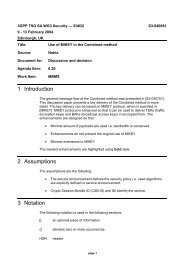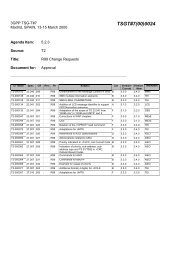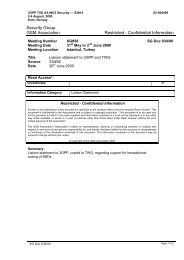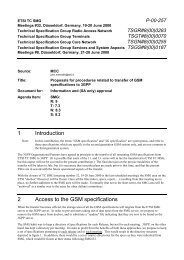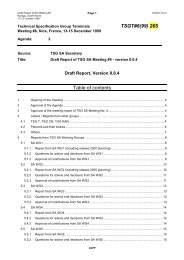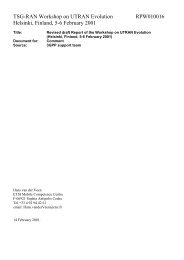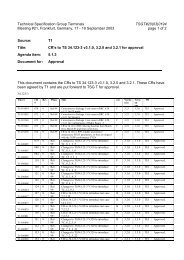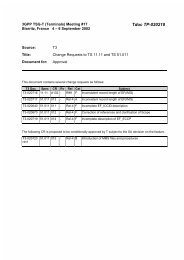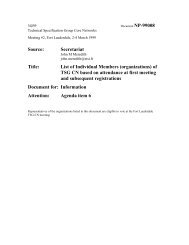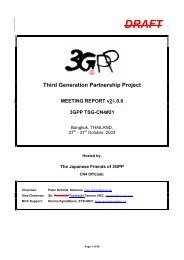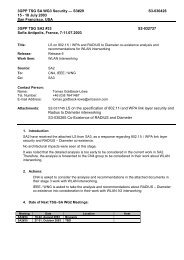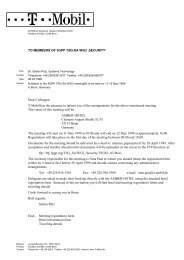1 Introduction 2 Simulation parameters - 3GPP
1 Introduction 2 Simulation parameters - 3GPP
1 Introduction 2 Simulation parameters - 3GPP
Create successful ePaper yourself
Turn your PDF publications into a flip-book with our unique Google optimized e-Paper software.
TSG-RAN Working Group 1 Meeting #20 TSGR1#20 (01)0539<br />
Busan, Korea<br />
May 21-25, 2001<br />
Agenda Item: AH24: High Speed Downlink Packet Access<br />
Source: Wiscom Technologies<br />
Title: Use Long-Range Prediction to Improve the Performance of AMCS<br />
and HARQ in Mobility Support of HSDPA<br />
Document for: Discussion<br />
1 <strong>Introduction</strong><br />
In previous HSDPA feasibility study [1], most system level study related to HARQ focused on the lowspeed<br />
scenarios. In the last TSG-RAN WG1/WG2 joint meeting, it is agreed that as a requirement<br />
HSDPA should provide full mobility support, including low-speed, medium-speed and high-speed<br />
scenarios. Thus it is of interesting to study the system level performance of HARQ for medium to high<br />
vehicle speed scenarios. The technique of long-range prediction (LRP) [4,5,9,10] has been proposed to<br />
compensate the MCS selection delay and hence improve the performance in low to medium-speed<br />
cases. In this contribution, we present the simulation results of using long-range prediction to improve<br />
the system performance of AMCS and HARQ in medium to high-speed (15, 30, 120Kmph) mobility<br />
support of HSDPA.<br />
2 <strong>Simulation</strong> <strong>parameters</strong><br />
<strong>Simulation</strong> <strong>parameters</strong> are similar to the simulation case 1 in Section 11.3.7.1 of [1] and listed below.<br />
Parameter Explanation/Assumption Comments<br />
CPICH power -10 dB 10% of total cell power<br />
Other channels - 7 dB 20% of total cell power<br />
Ec/Ior for HSDPA transmission -1.55 dB 70% of total cell power<br />
MCS selection rule CPICH measurement<br />
MCS update rate once per 3.33ms (5TS HSDPA frame)<br />
CPICH measurement transmission delay 1 HSDPA frame<br />
MCS selection delay 1 HSDPA frame after receiving<br />
measurement report<br />
Std. dev. of CPICH measurement error varying, based on the CPICH symbol<br />
average<br />
CPICH measurement rate once per 3.33ms<br />
CPICH measurement report error rate 0%<br />
Fast HARQ feedback error rate 0%<br />
Max. # of retransmissions 10/15 Retransmissions by fast HARQ<br />
MCS levels QPSK 1/2 & 3/4, 16QAM1/2 & 3/4,<br />
64QAM 3/4.<br />
Fast HARQ scheme 2-channel stop-and-wait with Chase<br />
combining<br />
STTD On<br />
Carrier frequency 2 GHz<br />
Specify Fast Fading model 1-path Rayleigh with speed 15, 30, 120<br />
Kmph<br />
The effective SIR is the sum of SIR’s<br />
of all combining packets.<br />
Jakes model<br />
Page 1 of 4
3 <strong>Simulation</strong> Results<br />
In lower speed scenario (such as speed 5dB or Ec/Ioc < -5dB, the MCS selection is more<br />
likely to be the highest or lowest MCS. Thus the difference between prediction and non-prediction<br />
decreases as expected.<br />
Figure 2 shows the throughput versus Ec/Ioc of a single code for HSDPA with and without the channel<br />
prediction at 30Kmph. Notice that for this medium speed the performance improvement by channel<br />
prediction is 0.5 to 1.0 dB with Ec/Ioc between –5 to 5dB.<br />
Figure 3 shows the throughput versus Ec/Ioc of a single code for HSDPA without the channel<br />
prediction at 120Kmph. For this high-speed case, the channel prediction is not feasible for<br />
corresponding Rayleigh fading. The MCS selection is likely determined by the mean SNR over<br />
Rayleigh fading. However, if both Rayleigh and shadow (lognormal) fading are considered, it might be<br />
possible to predict the fluctuation of shadow fading and hence precede proper MCS selection to<br />
improve the throughput.<br />
Figure 1. Throughput versus Ec/Ioc with and without channel prediction. Total delay=2 HSDPA<br />
frame, 1-path Rayleigh channel, speed = 15kmph, STTD on, HARQ with Chase Combining, ideal<br />
feedback. Max re-transmission=15.<br />
Page 2 of 4
Figure 2. Throughput versus Ec/Ioc with and without channel prediction. Total delay=2 HSDPA<br />
frame, 1-path Rayleigh channel, speed = 30kmph, STTD on, HARQ with Chase Combining, ideal<br />
feedback. Max re-transmission=10.<br />
Figure 3. Throughput versus Ec/Ioc without prediction. Total delay=2 HSDPA frame, 1-path<br />
Rayleigh channel, speed = 120kmph, STTD on, HARQ with Chase Combining, ideal feedback.<br />
Max re-transmission=10.<br />
4 Conclusion<br />
We evaluate the throughput performance in medium to high vehicle speed scenarios for mobility<br />
support of HSDPA. For medium-speed case (such as 10 to 30Kmph), the technique of long-range<br />
prediction (LRP) can be used to improve the system performance. For high-speed case, it might be<br />
Page 3 of 4
possible to predict the signal fluctuation due to shadow fading and thus improve the throughput.<br />
Further study is needed. Based on the potential performance improvement, the long-range prediction<br />
(LRP) technique [4,5,9,10] should be incorporated with AMCS and HARQ, especially in the mobility<br />
support of HSDPA.<br />
5 References<br />
[1] <strong>3GPP</strong> TR V0.6.0 (2000-05), Physical Layer Aspects of UTRA High Speed Downlink Packet Access,<br />
(Release 2000), TSG-RAN Working Group1 meeting#19, TSGR1#19, R1-01-0430, Las Vegas, USA, 27 th<br />
Feb.-2 nd March, 2001<br />
[2] TSG RAN R1-00-1326, Wiscom Technologies, “Link level simulation results for HSDPA”,<br />
TSGR1#17, Stockholm, Sweden, November 21-24, 2000.<br />
[3] TSG RAN R1-00-1327, Wiscom Technologies, “Influence of channel estimation on the link level<br />
performance of HSDPA”, TSGR #17, Stockholm, Sweden, November 21-24, 2000.<br />
[4] TSG RAN R1-00-1393, Wiscom Technologies, “Use of Long-Range Prediction for channel<br />
estimation and its application in HSDPA”, TSGR1#17, Stockholm, Sweden, November 21-24, 2000.<br />
[5] TSG RAN R1-01-0025, Wiscom Technologies, “On the Need of Long-Range Prediction of Channel<br />
Estimation in HSDPA and Text Proposal”, TSGR1#18, Boston, MA, USA, January 15-18, 2001.<br />
[6] TSG RAN R1-01-0050,Wiscom Technologies, "Performance of AMCS and HARQ for HSDPA in the<br />
non-ideal measurement and feedback situations", TSGR1#18, Boston, MA, USA, January 15-18, 2001.<br />
[7] TSG RAN R1-01-0051, Wiscom Technologies, “Effect of MCS selection delay on the performance of<br />
AMCS and HARQ for HSDPA”, TSGR1#18, Boston, Massachusetts, USA, Jan. 15-18, 2001.<br />
[8] TSG RAN R1-01-0136, Wiscom Technologies, “<strong>Simulation</strong> results for Section 13.3.7.1 of TR<br />
25.848”, TSGR1#18, Boston, MA, USA, Jan. 15-18, 2001.<br />
[9] TSG RAN R1-01-0248, Wiscom Technologies, “Use Long-Range Prediction to Improve the<br />
Performance of AMCS and HARQ with MCS Delay”, TSGR1#19, Las Vegas, NV, USA, Feb. 27-<br />
March 2, 2001.<br />
[10] TSG RAN R1-01-0249, Wiscom Technologies, “Long-Range Prediction (LRP) of Faded Signals<br />
in HSDPA for FDD and TDD”, TSGR1#19, Las Vegas, NV, USA, Feb. 27-March 2, 2001.<br />
[11] TSG RAN R1-01-0538, Wiscom Technologies, “Link Level Performance of HARQ with Chase<br />
Combining for Medium and High Vehicle Speed”, TSGR1#20, Busan, Korea, May21-25, 2001.<br />
Page 4 of 4



